Samsung Galaxy Z Flip review: Admire it, don't buy it
It's the best foldable I've used, but I still have concerns.
To date, every foldable you could buy has been the subject of at least some drama. Royole's FlexPai felt barely finished. The original Galaxy Fold wasn't much more than a prototype, with glaring design issues that were fixed in later production runs. Huawei's Mate X stole the show at last year's Mobile World Congress but was delayed for reasons the company never fully explained. And the Razr? Well, let's just say the results couldn't possibly live up to the hype.
The Galaxy Z Flip ($1,380) is different. Of all the foldables I've used, this is the first one that seems to tick all the boxes: Excellent performance, great cameras, and even decent battery life — all packed into a flip-phone-style body that I honestly think makes the most sense for most people. If you're in a rush to embrace one possible future for smartphones, then I don't think you'll do much better than this.
But why rush? Embracing that future means putting up with a lot of compromises. And even though the Z Flip has fewer than most, the same lingering foldable criticisms apply. They're more expensive than comparable smartphones. They're inherently fragile and app-makers don't know how to take advantage of them (yet). The Z Flip may be the best of its kind, but until foldables as a whole mature beyond these problems, they're still not worth the splurge for anyone who doesn't want to double as a beta tester.
Key specs
Samsung Galaxy Z Flip | |
|---|---|
Processor | Octa-core Snapdragon 855+ |
RAM / storage | 8GB/256GB |
MicroSD card support | N/A |
Main Display | 6.7-inch Dynamic AMOLED Infinity Flex |
Display resolution | 2,636 x 1,080 (21.9:9) |
External Display | 1.1-inch Super AMOLED |
Display resolution | 300 x 112 |
Rear cameras | 12MP f/2.2 ultra-wide angle camera, 12MP f/1.8 wide-angle camera with Super Speed Dual Pixel AF and OIS |
Front-facing camera | 10MP f/2.4 camera |
OS | Android 10 with One UI 2.0 |
Battery | 3,300mAh |
Charging | USB-C, supports QuickCharge 2.0 and Samsung Adaptive Fast Charging |
Dimensions | 73.6 x 87.4 x 17.3-15.4mm (closed), 73.6 x 167.3 x 7.2-6.9mm (closed) |
Weight | 183g |
Fingerprint sensor | Yes, side-mounted |
Waterproofing | N/A |
NFC | Yes |
Headphone jack | No |
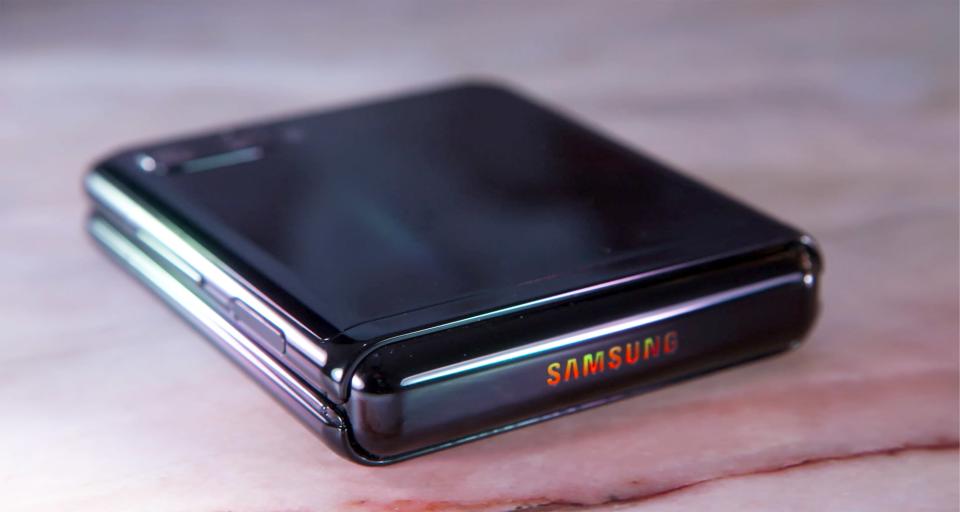
Design and durability
Late last year, I found myself on an impromptu holiday in Germany, freezing from the moment I stepped off the plane. The first item on my to-do list? Get a coat, and fast. The result of that impulse buy is a jacket I absolutely adore, but one with a shallow, strangely-angled inside pocket that my phone always peeks out of, like it's contemplating a hasty escape. Not this time. The Galaxy Z Flip fits in there perfectly.
There will probably always be a place for devices that pull double duty as smartphones and as small tablets, but I prefer devices like the Razr and the Galaxy Z Flip because they offer full smartphone functionality when you need it and disappear into a tight pocket or small purse when you don't. And so far, Samsung's approach to that form factor is the most elegant we've seen.
That doesn't, however, mean the Z Flip is attractive. Much like this year's Galaxy S20 lineup (with the possible exception of the S20 Ultra and its wild rear camera array), the Z Flip looks, well, pretty boring. Our black model has all the flair and panache of a Game Boy Advance SP, though the luminescent violet model is pretty in a Huawei P20 Pro sort of way and there's a spendy Thom Browne edition if you're into the whole Aquafresh aesthetic. Beyond that, though, the Z Flip is almost surprisingly nondescript. When closed, you'll find the volume keys and fingerprint sensor/power button on the right side, the nanoSIM slot on the left, and the main dual camera up front, next to a tiny, 1-inch external screen. I can't say I'm a fan.
It's ideal for quickly glancing at the time, and you use swipe over to view your media controls in a pinch, but for nearly everything else, it's just too small to be truly useful. Let's say you want to triage some of your notifications: You handle that by swiping to the right and tapping on the corresponding app icon. Fair enough, but the screen's narrow dimensions mean the contents of those notifications scroll across it, and the screen almost always shut off before I could read the whole thing. (I've conferred with others I know who have been testing the Z Flip, and if there's a way to fix this in the settings, we can't find it.) The external screen also doubles as a viewfinder for selfies when using the main camera, but you only ever get to see a sliver of the action. It's enough to make sure that you're in the frame, but it also means whatever's in the background remains a surprise until you open the phone.
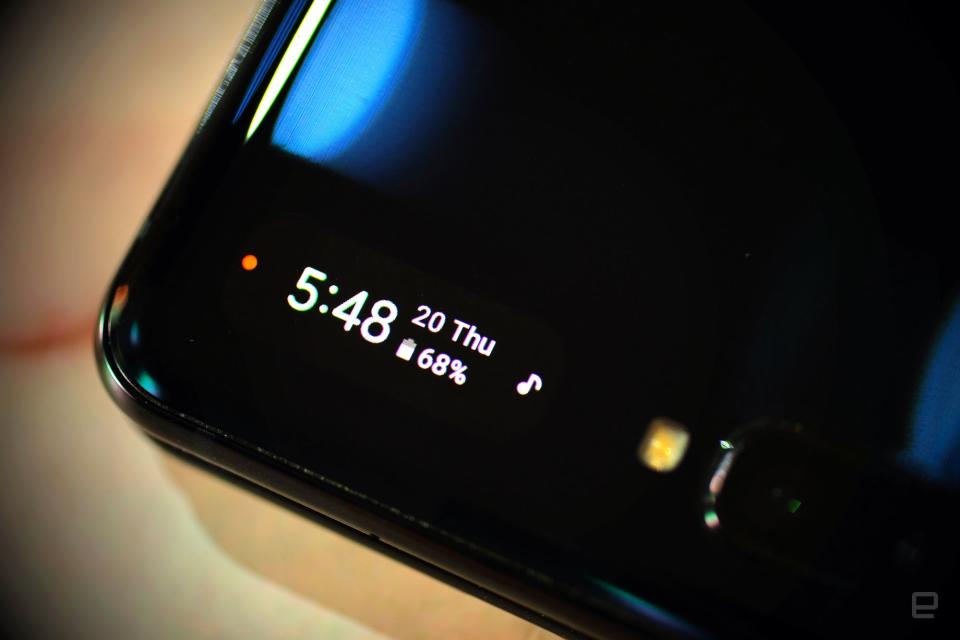
I get why Samsung would use a highly limited screen like this as it was probably much easier to build into a Z Flip than something more expansive, and I'm sure it cost less, too. Even with those constraints in mind, Samsung's approach here feels surprisingly inelegant. At least in this one area, Motorola's Razr has a clear advantage.
So yeah, the Z Flip's design could've used a little more thinking through. The bigger question is whether this new take on a classic design can withstand long-term use, and we just can't definitively answer that yet. What I can say, though, is that despite an improved design and much-needed upgrades to the folding mechanism, I still have some concerns.
Let's start with the hinge. It's the most complex and crucial part of this entire endeavor, and to Samsung's credit, the one in the Z Flip feels much sturdier than the version found in the Galaxy Fold. So far, that seems more blessing than curse — it gives the Flip a sense of stability that the Fold didn't really have, and Samsung's design here means you can open the phone halfway and set it down on a table for photo shoots or video calls. The only immediate downside is that it isn't as easy to flip open with one hand as, say, the Razr, but you'll get the hang of it soon enough. (Pro tip: It's all in the wrist.)
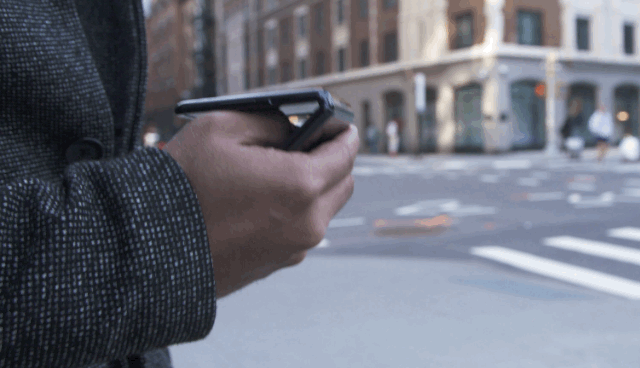
There are, however, a few less obvious shortcomings. Samsung says there are nylon "brushes" inside the Z Flip to help keep dust and debris out of the phone's all-important hinge — you can actually hear those fibers moving around if you press your ear up to the phone while opening or closing it. This "brushing technology" — Samsung actually calls it that — may sound effective, but a recent iFixit test revealed that there are limits to how much cleaning those fibers can do. After they tossed the phone in a plastic bag full of, uh, purple sand, the Z Flip's hinge started making some concerning popping sounds. Like the Fold, you definitely should not take the Z Flip to the beach.
With more careful use, Samsung says the Z Flip is rated for about 200,000 folds or about five years of actual use. That sounds great, but I'd take that figure with a grain of salt — it's only been about a year since the first foldables hit the market, so anyone making promises about longevity is just hypothesizing in front of you.
Oh, and there's more. Unlike the Razr, which closes completely, there's still a noticeable gap between the Z Flip's two halves when it's folded. It's not hard to imagine some pocket debris sneaking in there and scratching that internal display, even if the odds of serious damage seems pretty unlikely. Samsung also used the same T-shaped caps we saw in the redesigned Galaxy Fold to help seal the display around the hinges, which should keep larger bits of foreign material out of the phone, but it's important to remember the Z Flip isn't rated for water or dust resistance at all. It might be the best foldable I've tested so far, but you should still keep those kid gloves on.
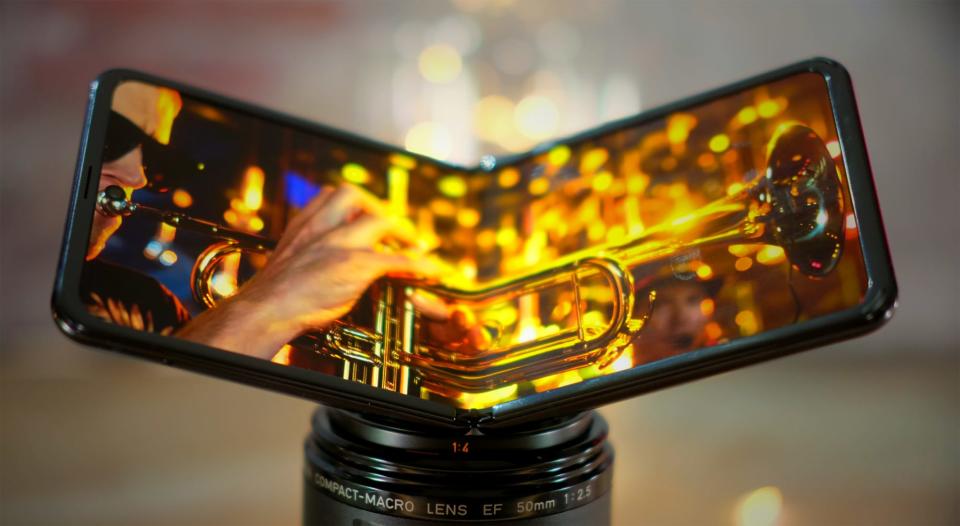
A "flexible glass" display?
The star of any foldable is its screen, and the one on the Galaxy Z Flip looks great. It's a 6.7-inch Dynamic AMOLED panel, with the same vibrant colors and great viewing angles you'd expect from a Samsung display. Unlike the Razr, the Z Flip's screen is also bright enough to be usable outdoors — it would've been nice if Samsung had bumped up the display's maximum brightness a notch or two, but what we get is perfectly serviceable. To my surprise, using this extra-tall screen was also a lot more comfortable than I expected. People will small hands will struggle to reach the top of the display with one hand, but I never really had to shuffle mine up and down to reach the screen's farthest corners.
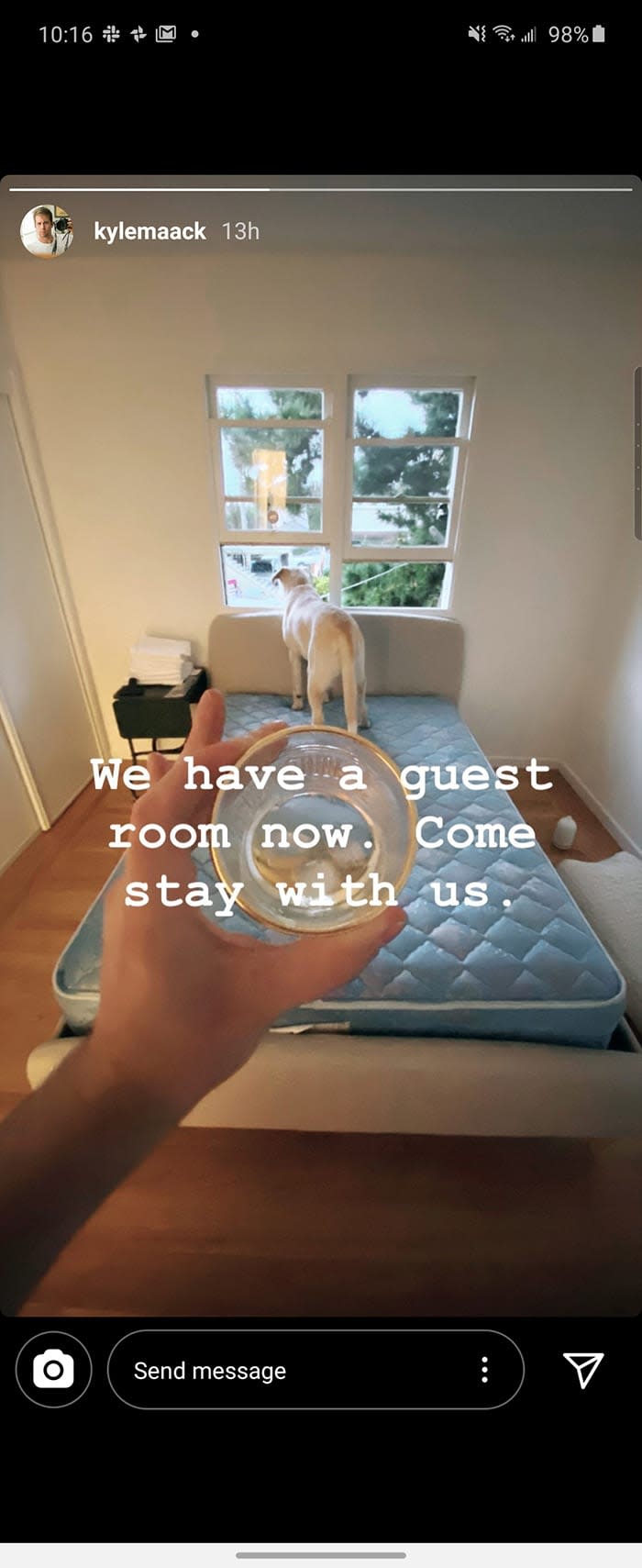
Practically speaking, there are only two notable shortcomings. First, its resolution: At 2636x1080, it's far less pixel-dense than a Galaxy S20, but you'll probably never notice the difference unless your nose is pushed up against the screen. The other is that, presumably because of its odd 21.9:9 aspect ratio, some apps don't scale to fit the screen properly. Instagram, for instance, displays its Stories with big black bars along the top and bottom, and some of them are cut off along the sides. Uber, meanwhile, just runs with some dead space along the bottom. Beyond those relatively minor issues, I have no complaints here.
Even so, this smartphone's screen is shaping up to be pretty controversial, all because of what's on top of it. Samsung has made a lot of noise about its ultra-thin, flexible glass since the Z Flip was announced a few weeks ago, to the point where the development sounded like a material science miracle. A glass screen! In a foldable! Someone finally figured it out!
I'll admit it: When I was at the Galaxy Unpacked event in San Francisco, I just took Samsung's word for it. What the company never bothered to make clear is that, glass or not, the Z Flip's screen still doesn't seem anywhere near as durable as a traditional smartphone display.
For one, it's still highly susceptible to scratches — our Z Flip's screen has already picked up a handful of them, and I can't for the life of me tell you how they got there. As it turns out, those scratches are appearing so readily because you're not directly touching the glass, but a thin layer of protective plastic sitting on top of it. (Like on the Galaxy Fold, it stretches under the display's raised bezels so it's near-impossible to remove accidentally.) It's not quite right to think of this as a mere screen protector, either. In a chilling YouTube teardown, Zack Nelson of JerryRigEverything peeled back the plastic and destroyed the display in the process. No, this plastic is an essential part of the screen itself, so be ready to see your fair share of nicks and gouges.
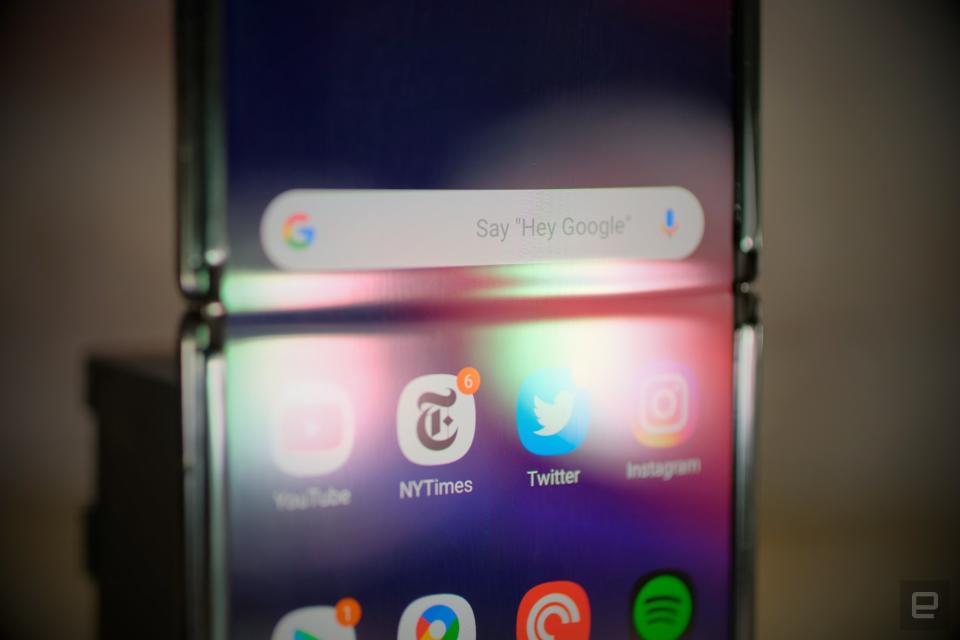
And then there's the ultra-thin glass itself. Our contacts at Samsung wouldn't directly confirm how thick this glass layer is, but the company's display division shed some light on its approach in a recent press release. The glass here is 30 microns, or 0.03mm thick — that's probably thinner than a sheet of paper you have sitting in your printer right now. To put that in perspective, Corning's widely used Gorilla Glass ranges from, 0.4mm to 2mm. No matter how you look at it, you're getting less protective glass here than you would with basically any other phone. It shows, too: That same YouTube teardown revealed that the Z Flip screen doesn't resist puncture damage very well, so God forbid you ever drop the phone face down on something. (For what's with worth, our unit survived a few accidental landings on clean ,hard floors without issue.)
In day-to-day use, the main benefit of this ultra-thin glass is that it just feels better. Apart from the crease, which is both mildly annoying and currently unavoidable for foldables — the Z Flip's screen feels just like a regular smartphone; there's no screen flexing or plastic squishiness here. That's important, for sure, but doesn't mean you should expect this screen to handle daily life as well as a traditional smartphone.
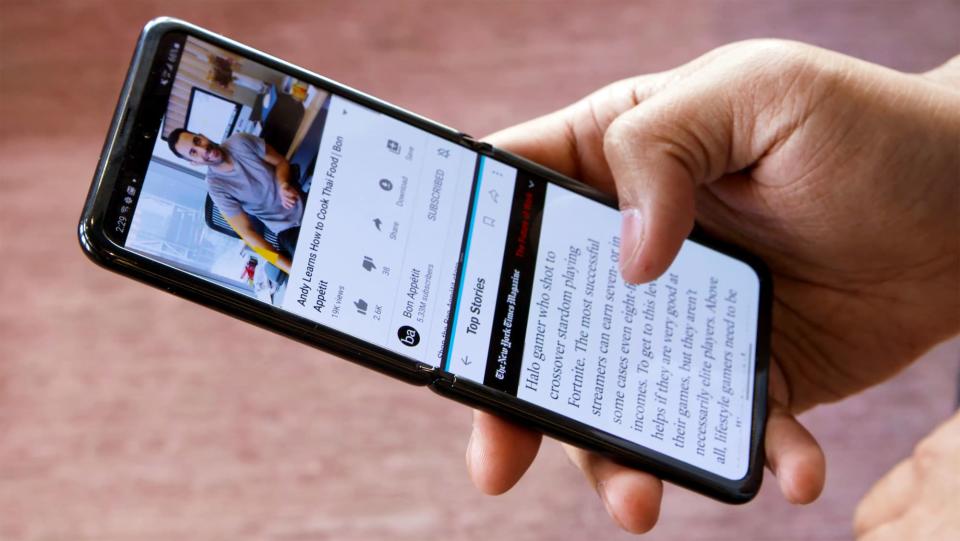
In use
A handful of foldables are available right now, but few of them were great at the whole "being a smartphone" thing. The Galaxy Fold was mostly meant to be used as a small tablet, and the Razr was so compromised that I can't imagine anyone finding its blend of disappointing battery life, bland cameras and mid-range performance worth it. By comparison, the Z Flip is in a class of its own — when it's open, it works and feels just like a proper, high-end smartphone.
Apart from the glass covering the screen, that's mostly thanks to Samsung's choice of components. There's a Snapdragon 855+ inside, along with 8GB of RAM and 256GB of storage. That's enough to put it right up there with the absolute best of last year's flagships. I've honestly struggled with this part of the review because there really isn't much to say — the Z Flip runs effortlessly smoothly, and there's more than enough power here for split-screen multitasking, high-performance gaming and just about anything else you'd want to throw at it. (That's something I definitely couldn't say about the Razr earlier this year.)
I know some of you are probably miffed that the Z Flip doesn't pack the same high-end parts as the new Galaxy S20s. That's fair — after all, the difference in price between this thing and a new Samsung flagship with an impeccable screen, top-of-the-line processor, a 100x Space Zoom camera and a massive battery is nearly negligible. And when you consider the Z Flip is also missing 5G support and expandable storage, it becomes clear that this just isn't a particularly future-proof phone. The Z Flip forces you to choose between those practical concerns and the intoxicating novelty of a phone that shrinks by half when you don't need it.
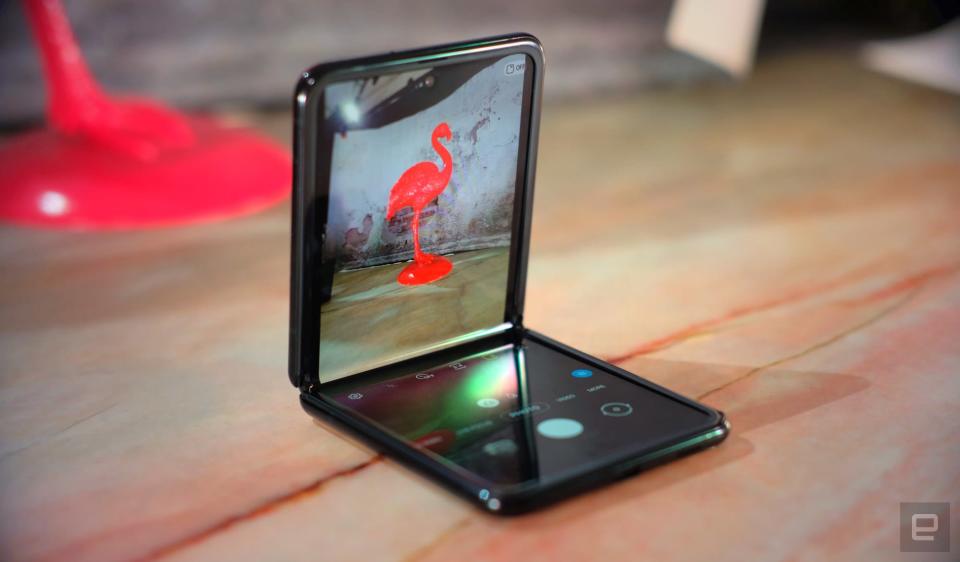
For what it's worth, Samsung tried to sweeten the deal a bit with its customized version of Android 10. It's mostly clean, albeit painted over with Samsung's updated One UI 2.0, but the most interesting tweak here is what the company calls Flex Mode — a feature that allows certain apps to reconfigure themselves as you start folding the phone. Need to check in on your family via Duo video call? Plop the Z Flip onto a table, bend the screen partway, and watch as your faces shift onto the screen's top half. And while the phone is sitting at attention, you can snap some photos, too. (The viewfinder faces you while the camera controls lay flat on the bottom half of the screen.)
These are neat flourishes, and propping the phone so it can take photos all by itself is genuinely helpful. (The Razr, by comparison, has almost no foldable-focused software enhancements.) Unfortunately, right now you can't use Flex Mode to do much more than what I've described but that should change in time. Google says it worked with Samsung to develop Flex Mode in the first place, and that it'll eventually become available on other foldable phones. Once that happens, app developers might not have a choice besides redesigning their software to play nice with the feature — for now, you can at least leave your tripod at home.
Thankfully, the cameras don't leave me with much to complain about. Samsung went with two 12-megapixel cameras, a standard and an ultra-wide, around back. Or on top. Or up front. No matter how you look at it, this camera setup isn't nearly as ambitious as we've seen on the Galaxy S20s, but there's still plenty to work with here. Both sensors capture eye-catching images, and, as always, Samsung's aggressive processing means the pictures you take almost always look more vibrant and dramatic than reality. (Whether that's a good thing is a matter of taste.) You'll spot plenty of detail, too, though that processing I just mentioned tends to turn some finer aspects indistinct if you zoom in enough.
Those details quickly get blurred into oblivion once it gets too dark — neither camera does particularly well in low light, but the ultra-wide is noticeably worse. In other words, all pretty standard stuff for Samsung cameras. I will say the lack of a dedicated telephoto camera is a bummer, but at least the Z Flip inherited the S20s' Single Take mode. Once enabled, the phone captures multiple video clips and stills so you get a nice variety of content without any extra work on your part. I've grown pretty fond of this feature, even though no telephoto lens means your selection of shots is less varied than what you'd get out of a Galaxy S20.
And then there's battery life, which is good, but not great by $1,400 phone standards. There are two batteries inside that collectively offer 3,300mAh of juice — to put things in perspective, even the smallest of the new Galaxy S20s has a 4,000mAh battery. In my experience, the Z Flip is good for one long day of use and not much else, though I should mention that I've been getting a solid five to five-and-a-half hours of screen on time here. That's a notable improvement over the Razr. Still, this isn't the kind of phone you should forget to charge overnight — if you do, you're in for some mild panic come the morning. Unfortunately, that's just a natural limitation of these kinds of foldables — having two movable segments means using multiple smaller batteries in tandem, which just isn't as power-efficient as a single big battery.
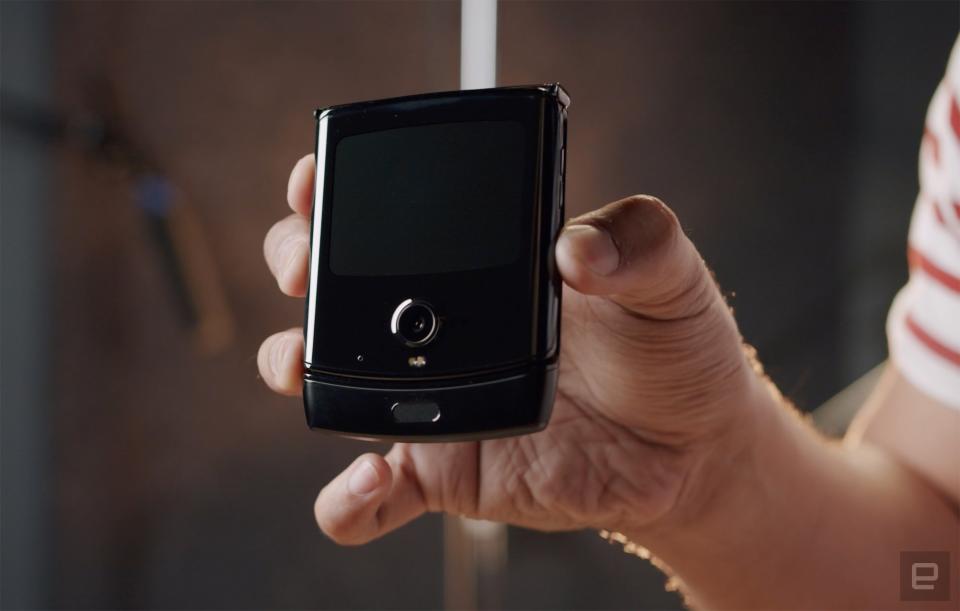
The competition
If you're itching for a foldable right now, your options are limited. There's the Galaxy Fold if you're into its small Android tablet vibe, but I have to assume that if you're considering the Z Flip in the first place, Samsung's other, more expensive foldable wasn't a serious contender for your cash. The only direct competitor right now is Motorola's $1,500 Razr, and I'll just end that debate right now: Unless you find yourself enamored with the Razr's throwback style, there's hardly anything that device does that the Z Flip doesn't do better.
We can't just leave things there, though. Because of its great performance and comparable price, the Z Flip also faces direct competition from the rest of 2020's premium smartphones. For about the same amount of money, you could also invest in Samsung's Galaxy S20 Ultra, a device that packs a much better screen, a much bigger battery, even more cameras and full 5G support. If you're reading this review the day it was published, we've only just started testing the Ultra, so for now I can't definitively say it's the better phone. Even so, it's an excellent object lesson: Yes, foldables are appealing for their flexibility, but if it's pure functionality you're after, a more traditional phone will almost always have the upper hand.
Wrap-up
If the last 3,000 words haven't already made it clear, I'm torn. I love how the Galaxy Z Flip gives me the smartphone I need when I need it, and how it nearly disappears into your pockets when I'm done. (Literally — it's small enough that I've misplaced the thing a few times now.) I love how Samsung didn't skimp on performance as Motorola did with the Razr. I love this thing, full stop. I just don't know if I can trust it.
Its inherent fragility, more than anything, is why I hesitate to embrace the Z Flip more fully. Sure, these things might last longer than Samsung suggests, but we don't live our lives in hermetically sealed labs. The real world is messy. Accidents happen. And simply because it's one of the industry's early foldables, the Z Flip almost certainly doesn't have the staying power of a less interesting glass-and-metal slab. At the end of it all, you want to ditch your current phone for something ambitious and exciting, the Galaxy Z Flip is your best, most elegant option. All I ask is that you remember this: Buying one doesn't just mean you're getting a new phone. It also means you're rolling the dice.

